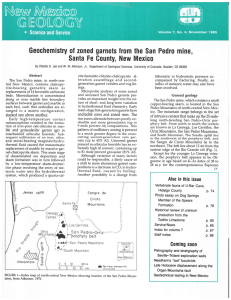LETTERS Crystal chemistry of Ca-bearing majorite American Mineralogist, Volume
advertisement
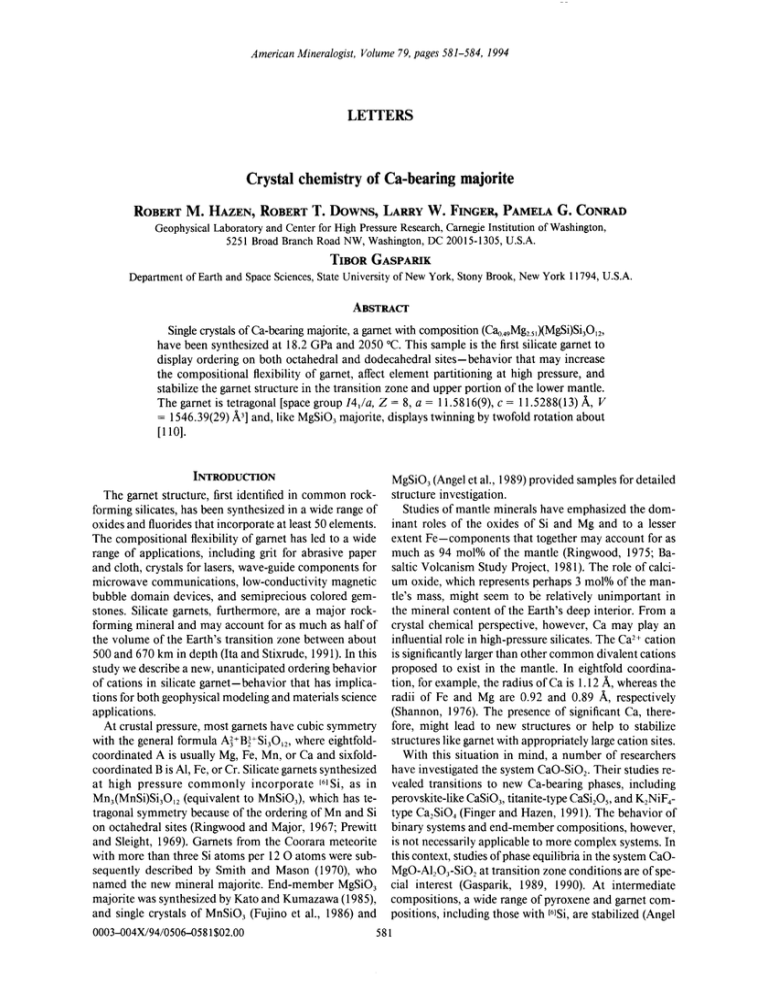
American Mineralogist, Volume 79, pages 581-584, 1994 LETTERS Crystal chemistry of Ca-bearing majorite ROBERT M. HAZEN, ROBERT T. DOWNS, LARRY W. FINGER, PAMELA G. CONRAD Geophysical Laboratory and Center for High Pressure Research, Carnegie Institution of Washington, 5251 Broad Branch Road NW, Washington, DC 20015-1305, U.S.A. TIBOR Department GASPARIK of Earth and Space Sciences, State University of New York, Stony Brook, New York 11794, U.S.A. ABSTRACT Single crystals of Ca-bearing majorite, a garnet with composition (Cao.49Mg2sl)(MgSi)SiPI2' have been synthesized at 18.2 GPa and 2050 0c. This sample is the first silicate garnet to display ordering on both octahedral and dodecahedral sites- behavior that may increase the compositional flexibility of garnet, affect element partitioning at high pressure, and stabilize the garnet structure in the transition zone and upper portion of the lower mantle. The garnet is tetragonal [space group 14/a, Z = 8, a = 11.5816(9), C = 11.5288(13) A, V = 1546.39(29) A3] and, like MgSiO, majorite, displays twinning by twofold rotation about [110]. INTRODUCTION MgSiO, (Angel et aI., 1989) provided samples for detailed The garnet structure, first identified in common rockforming silicates, has been synthesized in a wide range of oxides and fluorides that incorporate at least 50 elements. The compositional flexibility of garnet has led to a wide range of applications, including grit for abrasive paper and cloth, crystals for lasers, wave-guide components for microwave communications, low-conductivity magnetic bubble domain devices, and semiprecious colored gemstones. Silicate garnets, furthermore, are a major rockforming mineral and may account for as much as half of the volume of the Earth's transition zone between about 500 and 670 km in depth (Ita and Stixrude, 1991). In this study we describe a new, unanticipated ordering behavior of cations in silicate garnet- behavior that has implications for both geophysical modeling and materials science applications. At crustal pressure, most garnets have cubic symmetry with the general formula Aj+ B~+Si3012, where eightfoldcoordinated A is usually Mg, Fe, Mn, or Ca and sixfoldcoordinated B is AI, Fe, or Cr. Silicate garnets synthesized [6]Si, as in at high pressure commonly incorporate Mn3(MnSi)Si,OI2 (equivalent to MnSi03), which has tetragonal symmetry because of the ordering ofMn and Si on octahedral sites (Ringwood and Major, 1967; Prewitt and Sleight, 1969). Garnets from the Coorara meteorite with more than three Si atoms per 120 atoms were subsequentlY described by Smith and Mason (1970), who named the new mineral majorite. End-member MgSiOJ majorite was synthesized by Kato and Kumazawa (1985), and single crystals of MnSi03 (Fujino et aI., 1986) and structure investigation. Studies of mantle minerals have emphasized the dominant roles of the oxides of Si and Mg and to a lesser extent Fe-components that together may account for as much as 94 mol% of the mantle (Ringwood, 1975; Basaltic Volcanism Study Project, 1981). The role of calciurn oxide, which represents perhaps 3 mol% of the mantle's mass, might seem to be relatively unimportant in the mineral content of the Earth's deep interior. From a crystal chemical perspective, however, Ca may play an influential role in high-pressure silicates. The Ca2+ cation is significantly larger than other common divalent cations proposed to exist in the mantle. In eightfold coordination, for example, the radius of Ca is 1.12 A, whereas the radii of Fe and Mg are 0.92 and 0.89 A, respectively (Shannon, 1976). The presence of significant Ca, therefore, might lead to new structures or help to stabilize structures like garnet with appropriately large cation sites. With this situation in mind, a number of researchers have investigated the system CaO-Si02. Their studies revealed transitions to new Ca-bearing phases, including perovskite-like CaSi03, titanite-type CaSi20" and K2NiF4type Ca2Si04 (Finger and Hazen, 1991). The behavior of binary systems and end-member compositions, however, is not necessarily applicable to more complex systems. In this context, studies of phase equilibria in the system CaOMgO-A120J-Si02 at transition zone conditions are of special interest (Gasparik, 1989, 1990). At intermediate compositions, a wide range of pyroxene and garnet compositions, including those with [6]Si,are stabilized (Angel 0003--004X/94/0506--0581 $02.00 581 582 HAZEN ET AL.: CRYSTAL CHEMISTRY et aI., 1988, 1989). These complex silicate phases are not only relevant to the multielement environment of the Earth's deep interior, but they also have implications for the crystal chemistry of synthetic analogues. EXPERIMENTAL METHODS The sample, heated for 4 h to a maximum temperature of 2050 °C at 18.2 GPa in the USSA-2000 split-sphere anvil apparatus, produced numerous colorless crystals up to 100 Jtm diameter, as described by Gasparik (1990: expt. no. SUNY 868). Less calcic majorite and CaSiOJ perovskite formed at the cooler end of the sample assembly, estimated to have reached a temperature no higher than 1850 0c. Our work focused on crystals from the hotter end of the sample assembly. X-ray diffraction and electron microprobe study of the sample revealed both garnet and subcalcic diopside crystals in the experimental products of the sample assembly's hotter end. More than a dozen Ca-bearing majorite crystals were mounted for X-ray study, but most displayed multiple and smeared reflections. Only one crystal, an elongated shard approximately 30 and 70 Jtm in minimum and maximum dimensions, respectively, proved suitable for X-ray diffraction study. Electron microprobe analysis revealed an average composition of (Cao49Mg251)(MgSi)SiJOI2' slightly more calcic than the average composition of (Cao45Mg255)(MgSi)SiJOI2 reported by Gasparik (1990). A high-resolution multielement map of a portion of this crystal 20 x 20 Jtm revealed a generally uniform composition, but small areas display reduced Ca/Mg, corresponding to Ca contents as low as about (Cao4Mg26)(MgSi)SiJ012. Such compositional heterogeneity must contribute to the generally broad diffraction maxima observed for this sample. Intensity data were collected on a Rigaku AFC-5 fourcircle diffractometer equipped with a rotating-anode generator operated at 45 kVand 180 mA. We used graphitemonochromatized MoKa radiation (X = 0.7093 A) to measure a hemisphere of data to (sin O)/X= 0.71. A total of 4814 symmetry-allowed diffraction peaks were measured by w step scans. Diffraction maxima were uniformly weak and broad, and < 10% of the peaks with 20 values above 40° were observed. Most observed peaks were doublets, perhaps due to multiple crystals in close alignment. Doubling was not observed in 0-20 scans, indicating that peak splitting is not a consequence of pseudomerohedral twinning about [III], as observed in majorite (Wang et aI., 1993). The other known twinning in majorite, rotation about [110], is merohedral and docs not result in split reflections (Hatch and Ghose, 1989). One member of each split diffraction peak (presumably the component from the main crystal) was always well centered. Peaks were integrated by fitting step-scan data to multiple Gaussian functions; only the central peak was retained. Peaks that appeared to be single but significantly exceeded the expected peak width (implying an unresolved doublet) were rejected during this procedure, which yielded 80 I observed reflections. OF Ca-BEARING MAJORITE Intensities were corrected for Lorentz and polarization effects and reduced to structure factors. No correction was made for crystal absorption (Jtl= 14.3 cm-I). Systematic extinctions are consistent with space group 14/a, as previously reported for majorite (Angel et aI., 1989). Reflections were averaged according to Laue group 4/m (R;nt = 0.050), which yielded 195 symmetrically distinct observations (I 2: 30-). RESULTS AND DISCUSSION We initiated the crystal structure refinement with parameters reported by Angel et aI. (1989) for the Mg endmember, MgSiOJ. In addition to the scale factor and 25 variable atomic coordinates, we refined one occupancy parameter for Ca and Mg in Dl and D2, assuming a total composition of Cao49Mg251. We also refined a [l1O] twin fraction and five isotropic displacement factors (D I, D2, and one each of the other three site types, T, Oct, and 0), for a total of 33 refined parameters. Initial refinements also included a parameter for Mg and Si ordering on Oct! and Oct2, but preliminary results indicated complete Mg-Si order, and this parameter was omitted from later refinements. Refinements were performed with RFINE90, a version ofRFINE4 (Finger and Prince, 1975). Refinement converged to a weighted R of 0.057 and unweighted R of 0.066 for 195 observations. The goodness of fit for the converged refinement is 1.39. Calculated and observed structure factors are available from the authors. Refined positional and displacement parameters appear in Table I, and unit-cell parameters, selected interatomic distances, and bridging-O angles appear in Table 2. Ca-bearing majorite has a calculated density of 3.516 glcmJ for a composition of (Cao49Mg251)(MgSi)SiJOI2. Silicate garnets may be described in terms of a relatively rigid three-dimensional, comer-linked framework of silicate tetrahedra and octahedra (Fig. I). This framework defines eightfold-coordinated sites that are occupied by divalent cations. Tetragonal garnets have three symmetry-independent Si04 tetrahedra, all of which are nearly regular, with typical orthosilicate mean T-O distances close to 1.64 A. Octahedral Mg and Si order in the two symmetrically distinct octahedral sites, which are close to regular. This inflexible framework displays uniform bridging Oct-O-Si angles in all three specimens. The mean Oct 1-0 and Oct2-0 distances, 2.012 and 1.754 A, are typical of those found in Mg06 and Si06 octahedra, respectively. The Oct2-0 distances in MgSiOJ and MnSiOJ (1.807 and 1.795 A, respectively), however, are significantly longer than end-member Si-O octahedral distances. Furthermore, refined octahedral occupancies for both end-member MnSiOJ and MgSiOJ garnets indicate up to 20% disorder. The reasons for these differences in degree of octahedral order are not obvious. The MgSiOJ (Angel et aI., 1989) and MnSiOJ (Fujino et aI., 1986) samples were synthesized at lower temperatures (1700 and 1500 °C, respectively) and for shorter experiment durations «30 min) than Ca-bearing majorite (2050 °C for 4 h), so the latter HAZEN ET AL.: CRYSTAL CHEMISTRY TABLE 1. Positional and displacement parameters Site* Atom Occupancy D1** Mg Ca Mg Ca Mg Si Si Si Si 0 0 0 0 0 0 0.917 (36) 0.083 0.677 0.323 D2** Oct1 Oct2 T1 T2 T3 01 02 03 04 05 06 from the refinement of Ca-bearing x 0.0137 (13) V. 0 (9) (18) (17) (17) (18) (16) (17) 0 0 V. V. 0.0072 0.0524 -0.0462 0.1100 -0.0839 0.1585 0.2141 583 MAJORITE majorite y 0.1265 (11) 0 0 0 0 0.1259 0.0251 0.0420 0.2212 0.2172 -0.0530 -0.1024 OF Ca-BEARING z 8 (A') 0.2576 (12) 0.83 (28) 0.6258 (22) 2.20 (39) V2 0 % 0.44(9) 0.44 0.59 (15) 0.59 0.59 0.61 (14) 0.61 0.61 0.61 0.61 0.61 'I, (11) (17) (16) (17) (18) (17) (18) 0.7575 (10) 0.6666 (19) 0.8635 (19) 0.7934(16) 0.7026 (18) 0.4697 (19) 0.7842 (19) The origin of atomic coordinates is shifted by V2,O,O relative to the standard origin at the Wyckoff position 8e, to conform with previous * of cubic garnets. of each of these two sites are constrained to unity, with the total composition constrained to Ca Mg,.55' ** The total occupancies specimen might be expected to display more, not less, disorder. The nearly complete octahedral ordering in Ca-bearing majorite may, in part, be coupled with the unanticipated ordering of Ca and Mg on the two symmetrically distinct dodecahedral sites, Dl and D2. Ca is concentrated in the TABLE 2. Unit-cell parameters and selected distances (A) and angles (0) a (A) etA) ela v(A') D1-01 D1-02 D1-03 D1-03' D1-04 D1-04' D1-05 D1-06 Mean D1-0 D2-01 [21 D2-02[21 D2-05[21 D2-06[2] Mean D2-0 Oct1-01[2] Oct1-04[2] Oct1-05[2] Mean Oct1-0 Oct2-02[2] Oct2-03[2] Oct2-04[2] Mean Oct1-0 T1-05[4] T2-06[4] T3-01 T3-02 T3-03 T3-04 Mean T3-0 Oct1-01-T3 Oct2-02-T3 Oct2-03-T3 Oct1-04- T3 Oct1-05-T1 Oct2-06- T2 Mean Oct-O- T 11.5816 (9) 11.5288 (13) 0.9954 1546.4 (3) 2.105 (25) 2.429 (24) 2.309 (25) 2.522 (22) 2.084 (25) 2.305 (24) 2.178 (24) 2.696 (25) 2.329 2.354 (20) 2.414 (18) 2.177 (30) 2.217 (30) 2.291 2.035 (22) 2.035 (22) 1.967 (20) 2.012 1.731 (22) 1.730(20) 1.802 (20) 1.754 1.640 (21) 1.636 (20) 1.655 (22) 1.679 (22) 1.676 (23) 1.623 (23) 1.658 127.2 (13) 135.2 (12) 136.2 (13) 129.1 (13) 127.2 (11) 140.2 (13) 132.5 descriptions D2 site, which has a refined composition of Ca032Mg,,68' compared with CaOOgMg,,92for Dl. These site compositions may be expressed as a distribution coefficient: Ko = (XCam/ XMgm)/(XCao/ XMg01) = 5.4. This distribution coefficient is unusually large for a silicate quenched from high temperature: completely disordered sites have KD = 1, whereas most crustal silicates quenched from high temperature have KD < 2, especially for large cation sites that share edges and thus would seem to disorder easily (Hazen et aI., 1993). Furthermore, these two dodecahedral sites are not appreciably different in size, which is a con- Fig. 1. The structure oftetragonal Ca-bearing majorite (shown with one a axis vertical and the c axis to the left and diagonally out from the page) features a comer-linked framework of SiO. tetrahedra, Si06 octahedra (smaller), and Mg06 octahedra (larger), represented here as polyhedra. This framework defines two symmetrically distinct dodecahedral cation sites (spheres), which contain Ca and Mg. Ca concentrates in the D2 site, which is represented by the larger spheres. 584 HAZEN ET AL.: CRYSTAL CHEMISTRY trolling factor in cation ordering in some minerals. One possibly significant difference between Dl and D2 is the distribution of second-nearest neighbor cations (Fig. I). Distances between adjacent DI sites and between Dl and D2 are relatively short-approximately 3.5 A. Distances between closest D2 sites, on the other hand, are >5.7 A. Ordering of Ca onto D2 minimizes Ca-Ca interactions, which may be significant at the high pressure and temperature of Ca-bearing majorite synthesis. This study reveals the surprising structural complexity of tetragonal garnets. Of its seven symmetrically distinct cation sites, only the three Si tetrahedra display similar crystal chemical behavior. Cation distributions in the two octahedra and two dodecahedra demonstrate that these four sites behave differently and thus may incorporate a wide variety of major and minor elements. In geological environments, these distinct sites may provide mechanisms for element partitioning. Furthermore, the presence of extensive garnet solid solutions may expand its stability into pressure and temperature ranges of the upper portion of the lower mantle (O'Neill and Jeanloz, 1994). Chemical analyses of mantle-derived garnets with more than three Si atoms per 12 atoms underscore the ° chemical complexity of these high-pressure minerals (Moore and Gurney, 1985; Haggerty and Sautter, 1990). Gamet specimen JX-25 of Haggerty and Sautter, for example, has clinopyroxene exsolution lamellae in a garnet host, suggesting an original homogeneous composition of approximately (N aO.09Cao nMn002 Feo36Mg(82)(M~ 19AI'.48- CrOosSio23Tioo2)SiJO'2' Gamet compositional complexity is further demonstrated by Gasparik's (1992) synthesis of compositions approximating (NaMg2)(AISi)Si3 012, Mg3 (MgosAISios)Si3012, and (Na2Mg)Si2Si3012' Highpressure garnets are thus able to incorporate cations of valence 1+, 2 +, 3 +, and 4 + and cations of a wide range of size and electronic structure. Synthetic tetragonal garnets, though little explored, may display similar compositional complexities, as well as cation ordering- behavior that might enhance magnetic or optical properties. This study on garnets underscores a growing recognition that high-pressure silicates, even those synthesized at temperatures near 2000 °C, display a marked tendency for cation ordering (Aikawa et aI., 1985; Finger et aI., 1993). Most mantle silicates have ordering systematics not expected for low-pressure phases. In the case of majorite-type garnets, the tendency to order octahedral and dodecahedral cations appears to be a driving force behind the reduction of symmetry from the more typical cubic garnet symmetry. If so, then a similar, as yet unrecognized, symmetry breaking might occur in high-pressure silicate perovskites of an intermediate composition, such as CaMgSi206. ACKNOWLEDGMENTS The synthesis of single crystals was performed in the Stony Brook HighPressure Laboratory, which is jointly supported by the NSF Center for High Pressure Research and the State University of New York. X-ray diffraction work at the Geophysical Laboratory is supported by NSF grant no. EAR-9218845 and by the Carnegie Institution of Washington. OF Ca-BEARING MAJORITE REFERENCES CITED Aikawa, N., Kumazawa, M., and Tokonami, M. (1985) Temperature dependence of intersite distribution of Mg and Fe in olivine and the associated change in lattice parameters. Physics and Chemistry of Minerals, 12, 1-8. Angel, R.J., Gasparik, T., Ross, N.L., Finger, L.W., Prewitt, C.T., and Hazen, RM. (1988) A silica-rich sodium pyroxene phase with sixcoordinated silicon. Nature, 335, 156-158. Angel, R.J., Finger, L.W., Hazen, R.M., Kanzaki, M., Weidner, D.J., Liebermann, R.C., and Veblen, D.R. (1989) Structure and twinning of single-crystal MgSiO, garnet synthesized at 17 GPa and 1800 dc. American Mineralogist, 74, 509-512. Basaltic Volcanism Study Project (1981) Basaltic volcanism on terrestrial planets, 1286 p. Pergamon, New York. Finger, L.W., and Hazen, RM. (1991) Crystal chemistry of six-coordinated silicon: A key to understanding the Earth's deep interior. Acta Crystallographica, B47, 561-580. Finger, L.W., and Prince, E. (1975) A system of Fortran IV computer programs for crystal structure determination. National Bureau of Standards Technical Note 854, 128 p. Finger, L.W., Hazen, R.M., Ko, J., and Navrotsky, A. (1993) The effect of Fe on the crystal structure ofwadsleyite tI-(Mg,_,Fe,J,Si04, 0.00 :5 X:5 0.40. Physics and Chemistry of Minerals, 19,361-368. Fujino, K., Momoi, H., Sawamoto, H., and Kumazawa, M. (1986) Crystal structure and chemistry of MnSi03 tetragonal garnet. American Mineralogist, 71, 781-785. Gasparik, T. (1989) Transformation of enstatite-diopside-jadeite pyroxenes to garnet. Contributions to Mineralogy and Petrology, 102, 389405. (1990) Phase relations in the transition zone. Journal ofGeophysical Research, 95, 15751-15769. -(1992) Enstatite-jadeite join and its role in the Earth's mantle. Contributions to Mineralogy and Petrology, III, 283-298. Haggerty, S.E., and Sautter, V. (1990) Ultradeep (greater than 300 kilometers), ultramafic mantle xenoliths. Science, 248, 993-996. Hatch, D.M., and Ghose, S. (1989) Symmetry analysis of the phase transition and twinning in MgSi03 garnet: Implications to mantle mineralogy. American Mineralogist, 74, 1221-1224. Hazen, R.M., Finger, L.W., and Ko, J. (1993) Effects of pressure on MgFe ordering in orthopyroxene synthesized at 11.3 GPa and 1600 -C. American Mineralogist, 78, 1336-1339. Ita, J., and Stixrude, L. (1991) Petrology, elasticity, and composition of the mantle transition zone. Journal of Geophysical Research, 97, 68496866. Kato, T., and Kumazawa, M. (1985) Gamet phase of MgSi03 filling the pyroxene-ilmenite gap at very high temperature. Nature, 316, 803-805. Moore, R.O., and Gurney, J.J. (1985) Pyroxene solid solution in garnets included in diamond. Nature, 318, 553-555. O'Neill, B., and Jeanloz, R. (1994) MgSi03-FeSiO)-AI,03 in the Earth's lower mantle: Perovskite and garnet at 1200 km depth. Journal of Geophysical Research, in press. Prewitt, C.T., and Sleight, A.W. (1969) Gamet-like structures of highpressure cadmium germanate and calcium germanate. Science, 163, 386-387. Ringwood, A.E. (1975) Composition and petrology of the Earth's mantle, 617 p. McGraw-Hill, New York. Ringwood, A.E., and Major, A. (1967) Some high-pressure transformations of geophysical significance. Earth and Planetary Science Letters, 2, 106-110. Shannon, RD. (1976) Revised effective ionic radii and systematic studies of interatomic distances in halides and chalcogenides. Acta Crystallographica, A32, 751-767. Smith, J.V., and Mason, B. (1970) Pyroxene-garnet transformation in Coorara meteorite. Science, 168, 832-833. Wang, Y., Gasparik, T., and Liebermann, RC. (1993) Modulated microstructure in synthetic majorite. American Mineralogist, 78, 1165-1173. MANUSCRIPT RECEIVED FEBRUARY 24, 1994 MANUSCRIPT ACCEPTED MARCH 29, 1994

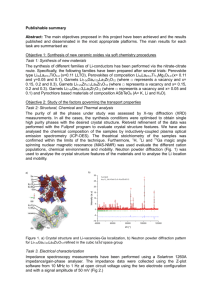

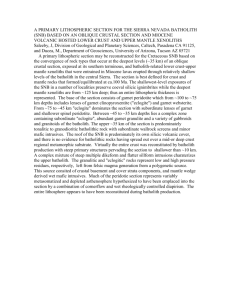
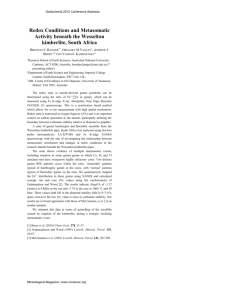

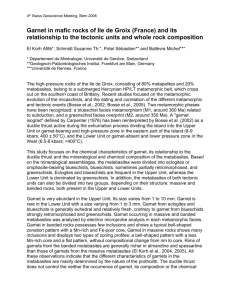
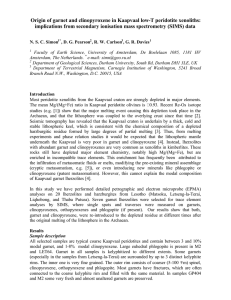
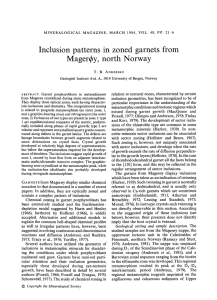
![Morphological Instabilities during Rapid Growth of Metamorphic Garnets PHYSICS []]CHIMISTRY (]]I]MIHIRALS](http://s2.studylib.net/store/data/011469444_1-314a9a2db0fedba2072206d8854069d6-300x300.png)
